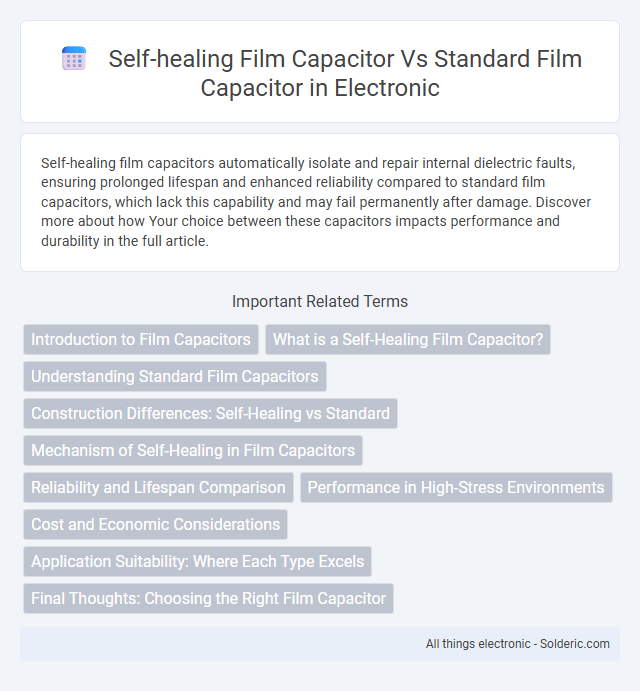Self-healing film capacitors automatically isolate and repair internal dielectric faults, ensuring prolonged lifespan and enhanced reliability compared to standard film capacitors, which lack this capability and may fail permanently after damage. Discover more about how Your choice between these capacitors impacts performance and durability in the full article.
Comparison Table
| Feature | Self-Healing Film Capacitor | Standard Film Capacitor |
|---|---|---|
| Definition | Capacitor with dielectric that repairs punctures automatically | Capacitor with fixed, non-repairing dielectric film |
| Dielectric Material | Metallized film (aluminum or zinc) | Foil or metallized film without self-healing properties |
| Self-Healing Ability | Yes, isolates faults and restores function | No, failure causes permanent damage |
| Reliability | High, enhances lifespan and safety | Lower, susceptible to catastrophic failure |
| Applications | Power electronics, motor drives, pulse applications | General purpose, low-stress circuits |
| Cost | Higher due to advanced materials and process | Lower, simpler manufacturing |
| Voltage Rating | Up to several kV | Varies, often lower voltage ratings |
| Energy Density | Higher due to metallized film | Lower, depending on film thickness |
Introduction to Film Capacitors
Film capacitors use a plastic film as the dielectric, providing high insulation resistance and low dissipation factor. Self-healing film capacitors contain a metallized film that can recover from dielectric breakdown by vaporizing the damaged area, enhancing reliability and longevity. Standard film capacitors with foil electrodes lack this self-healing property, making them more susceptible to permanent failure under electrical stress.
What is a Self-Healing Film Capacitor?
A self-healing film capacitor is designed with metallized film electrodes that automatically repair minor dielectric breakdowns by vaporizing the damaged area, restoring insulation and preventing failure. Unlike standard film capacitors, which may suffer permanent damage from electrical faults, self-healing capacitors enhance reliability and longevity in high-voltage applications. Your choice of a self-healing film capacitor ensures better performance in conditions where electrical stress could otherwise degrade capacitor function.
Understanding Standard Film Capacitors
Standard film capacitors use a dielectric film to store electrical energy, providing stable capacitance and low equivalent series resistance (ESR) ideal for filtering and signal processing. These capacitors rely on physical integrity, making them vulnerable to damage from voltage surges or dielectric breakdown. Understanding the construction and limitations of standard film capacitors helps in selecting the right component for applications requiring long-term reliability.
Construction Differences: Self-Healing vs Standard
Self-healing film capacitors feature a unique construction where a thin metal layer overlays a dielectric film, enabling automatic insulation repair when dielectric breakdown occurs, unlike standard film capacitors that lack this capability. This protective metal layer in self-healing capacitors isolates faults by vaporizing the damaged area, preserving capacitor functionality and extending lifespan. Your applications benefit from enhanced reliability and durability due to this advanced self-repair mechanism absent in standard film capacitor designs.
Mechanism of Self-Healing in Film Capacitors
Self-healing film capacitors contain metallized film electrodes that vaporize the tiny fault area upon dielectric breakdown, isolating defects and restoring functionality without compromising the entire capacitor. Standard film capacitors use separate metal foil electrodes and lack this self-repair mechanism, leading to permanent failure when dielectric faults occur. You can rely on self-healing capacitors for enhanced reliability and longer lifespan in applications prone to voltage spikes or dielectric stress.
Reliability and Lifespan Comparison
Self-healing film capacitors offer enhanced reliability by automatically repairing dielectric breakdowns, significantly reducing failure rates compared to standard film capacitors. Their ability to localize and isolate faults extends operational lifespan, making them ideal for demanding electrical applications. Your choice of self-healing capacitors ensures increased durability and consistent performance under stress conditions.
Performance in High-Stress Environments
Self-healing film capacitors exhibit superior performance in high-stress environments due to their ability to automatically isolate and repair internal dielectric breakdowns, ensuring continuous operation and extended lifespan. Standard film capacitors lack this self-repair mechanism, making them more susceptible to permanent failure under voltage surges, thermal stress, and electrical faults. The enhanced durability and reliability of self-healing capacitors make them ideal for applications with fluctuating voltages and harsh operating conditions.
Cost and Economic Considerations
Self-healing film capacitors generally have a higher upfront cost compared to standard film capacitors due to advanced materials and internal insulation technology that enhances durability and reliability. Over time, the self-healing capability reduces maintenance expenses and extends operational lifespan, leading to lower total cost of ownership in critical applications. Choosing your capacitor involves weighing immediate budget constraints against long-term savings and system performance requirements.
Application Suitability: Where Each Type Excels
Self-healing film capacitors excel in high-reliability applications such as power electronics, renewable energy systems, and electric vehicles due to their ability to recover from dielectric breakdowns and maintain long-term performance. Standard film capacitors are more suitable for general-purpose applications like audio equipment, lighting ballasts, and signal processing where cost-effectiveness and stable capacitance under normal operating conditions are priorities. Your choice depends on whether you prioritize durability and fault tolerance over economical and straightforward usage.
Final Thoughts: Choosing the Right Film Capacitor
Self-healing film capacitors offer enhanced reliability and longer lifespan by automatically repairing dielectric faults, making them ideal for applications requiring high durability and stability. Standard film capacitors typically provide cost-effective solutions but lack the self-repair feature, suitable for less demanding environments. Selecting the right film capacitor depends on balancing performance needs with budget constraints and operational conditions.
self-healing film capacitor vs standard film capacitor Infographic

 solderic.com
solderic.com